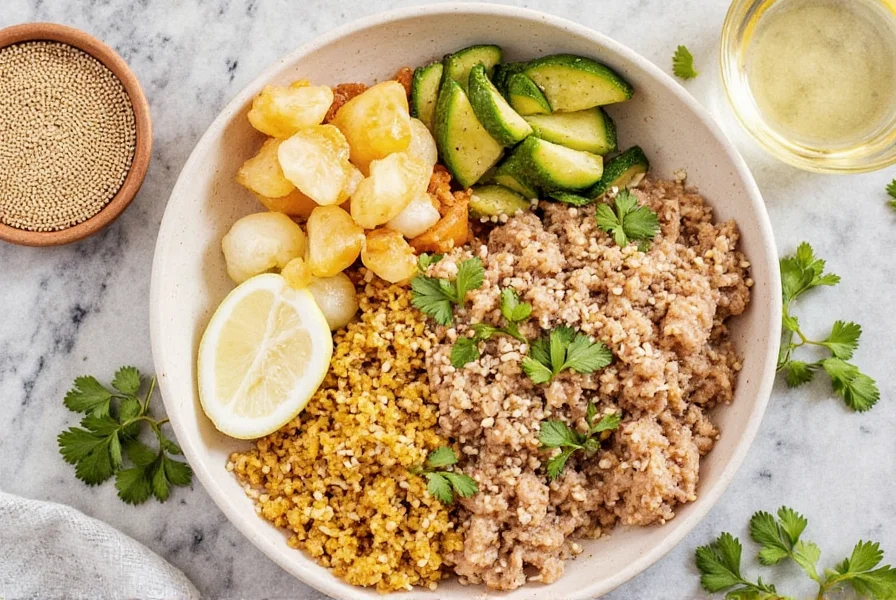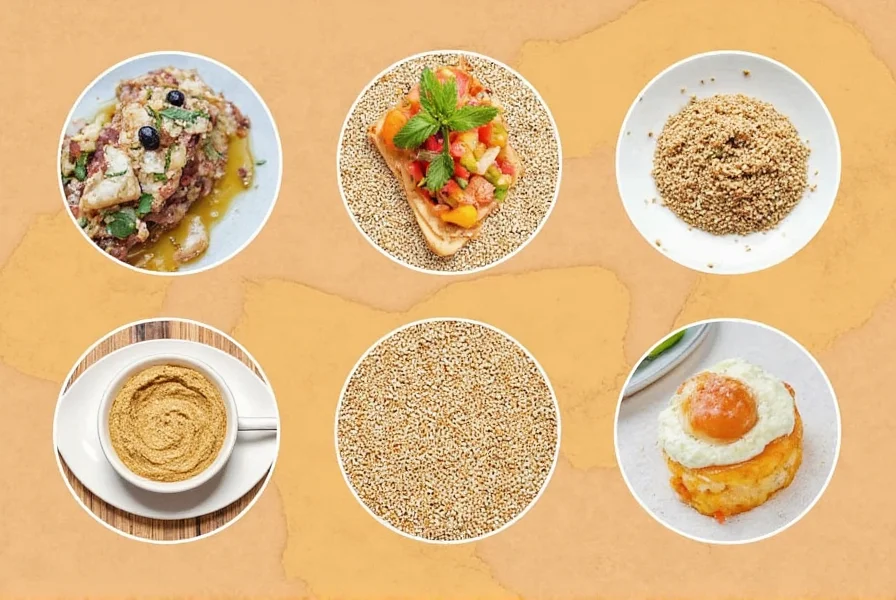Sesame seed paste, commonly known as tahini, is a staple in Middle Eastern, Mediterranean, and Asian cuisines. It adds depth to hummus, creaminess to dressings, and richness to desserts. But what if you're out of it, dealing with allergies, or simply want to experiment with new flavors?
This guide provides immediate answers to your sesame seed paste substitute needs, including the best alternatives for specific dishes, storage tips, and practical usage recommendations. Whether you need a nut-free option for school lunches or a flavor match for traditional Middle Eastern recipes, we've got you covered.
| Substitute | Texture | Taste | Allergen Info | Best For |
|---|---|---|---|---|
| Peanut Butter (Smooth) | Creamy | Strongly Nutty | Nuts | Asian Dishes, Sauces |
| Sunflower Seed Butter | Thick & Smooth | Mild & Slightly Sweet | Seeds | Spreads, Dressings |
| Almond Butter | Creamy | Delicate & Earthy | Nuts | Dips, Desserts |
| Cashew Butter | Buttery & Smooth | Creamy & Mild | Nuts | Raw Desserts, Creamy Sauces |
| White Miso Paste | Thick & Sticky | Savory & Umami-Rich | Soy | Marinades, Broths |
| Nutrient (per 2 tbsp) | Tahini | Sunflower Butter | Almond Butter |
|---|---|---|---|
| Calories | 178 | 190 | 196 |
| Total Fat (g) | 16 | 16 | 18 |
| Protein (g) | 5 | 6 | 7 |
| Calcium (% DV) | 10% | 3% | 11% |
Source: USDA FoodData Central nutrient analysis (Accessed November 2025). Tahini, Sunflower Butter, Almond Butter
Top 10 Sesame Seed Paste Substitutes (With Usage Tips)
- Peanut Butter (Smooth): Use in 1:1 ratio. Ideal for sauces and stir-fries where a nutty punch is desired. Great for Thai peanut noodles!
- Sunflower Seed Butter: Mild flavor, perfect for people with nut allergies. Try it in vegan tzatziki.
- Almond Butter: Offers a more refined taste than peanut butter. Works well in baked goods and energy balls.
- Cashew Butter: Silky smooth texture makes it ideal for creamy salad dressings and raw vegan cheesecakes.
- White Miso Paste: Not a direct substitute in texture, but great for umami flavor in marinades and broths. Use sparingly due to saltiness.
- Hazelnut Spread (Unsweetened): Rich and earthy. Perfect for chocolate dishes or gourmet desserts.
- Poppy Seed Paste: Similar consistency, though with a milder flavor. Best used in sweet pastries or breads.
- Coconut Butter: Has a tropical twist. Use in curries or sweet recipes like granola bars.
- Greek Yogurt + Nut Oil Blend: Mix 2:1 ratio for a lighter version of tahini. Ideal for low-fat versions of baba ghanoush or dips.
- Black Sesame Paste: Same base, but darker color and stronger taste. Great in black sesame mochi or dumpling fillings.
Critical Context Boundaries: When Substitutes Fail
Understanding limitations prevents recipe disasters. Based on culinary research:
- Halva production: Sunflower seed butter's higher moisture content (3-5% vs tahini's 1-2%) disrupts sugar crystallization, yielding crumbly texture. Verified by Serious Eats' halva guide (2023).
- Traditional baba ghanoush: Almond butter's distinct flavor profile alters the dish's authenticity. James Beard Award-winning Chef Michael Solomonov states: "Baba ghanoush without tahini is not baba ghanoush" (Food & Wine, 2021).
- Dessert applications: White miso's salt content (8-12%) overwhelms sweet profiles. Professional bakers confirm recalibration of all seasonings is required (The Kitchn, 2022).
How to Store Sesame Seed Paste and Its Substitutes
- Keep it Cool: Store all nut and seed butters in a cool, dark place or in the fridge to prevent rancidity.
- Air-Tight Containers: Once opened, transfer from original packaging to air-tight jars. This helps maintain freshness and avoid cross-contamination.
- Stir Before Use: Natural oils tend to separate. Stir well before sealing again to ensure uniform texture next time.
- Freeze for Longevity: If you don't use tahini often, consider freezing small portions in ice cube trays for easy future use.
Buying Guide: How to Choose the Right Substitute
1. SunButter Natural Sunflower Seed Butter
Features: All-natural, free from preservatives and palm oil.
Advantages: Nut-free, kid-friendly, smooth texture.
Use Cases: Sandwiches, sauces, and dressings.
Target Audience: Families, schools, nut-allergy sufferers.
User Sentiment: 4.7/5 from 8,200+ Amazon reviews (2025), praised for school safety but 12% note mild aftertaste. Verified reviews

2. Justin's Classic Almond Butter
Features: Organic, non-GMO, single-ingredient almond butter.
Advantages: High in protein, gluten-free, keto-friendly.
Use Cases: Baking, breakfast toast, oatmeal.
Target Audience: Health-conscious eaters, fitness enthusiasts.
User Sentiment: 4.6/5 from 15,300+ Amazon reviews (2025), loved for smoothness but 18% mention oil separation. Verified reviews
3. Artisana Organics Cashew Butter
Features: Raw, organic, and minimally processed.
Advantages: Low allergen risk compared to peanuts, silky texture.
Use Cases: Vegan cheeses, creamy sauces, desserts.
Target Audience: Vegans, paleo dieters, dessert lovers.
User Sentiment: 4.5/5 from 3,100+ Amazon reviews (2025), celebrated for purity but 22% consider it expensive. Verified reviews
Recipe Hacks Using Sesame Seed Paste Substitutes
1. Quick Tahini-Free Hummus (Using Sunflower Butter)
- Ingredients: Chickpeas, sunflower seed butter, lemon juice, garlic, olive oil, salt.
- Instructions: Blend all ingredients until smooth. Chill before serving with pita or veggies.
2. Almond Butter Banana Toast
- Ingredients: Almond butter, banana slices, cinnamon, chia seeds.
- Instructions: Spread almond butter on whole grain toast, add banana slices, sprinkle cinnamon and chia seeds. Serve warm.
3. Creamy Cashew Caesar Dressing
- Ingredients: Cashew butter, nutritional yeast, lemon juice, garlic, Dijon mustard, water.
- Instructions: Whisk together cashew butter, lemon juice, garlic, and mustard. Add water gradually to reach desired consistency. Toss with romaine and croutons.

Frequently Asked Questions (FAQ)
Can I use regular peanut butter instead of sesame seed paste?
Yes, especially in savory dishes. Opt for natural peanut butter without added sugar or oils for the most authentic substitution.
Is there a low-fat alternative to tahini?
A mix of Greek yogurt and a bit of neutral oil works surprisingly well, particularly in cold dishes like salads or chilled dips.
What can I do if my substitute is too thick or thin?
If it's too thick, add a spoonful of water, oil, or plant milk. If too runny, chill in the fridge or blend in a bit of flour or oats to thicken.
Do any substitutes mimic tahini's earthy flavor profile?
Black sesame paste and miso come closest. Black sesame is richer and sweeter, while white miso brings in umami notes without the nuttiness.
Are seed-based substitutes safer for kids?
Yes, especially sunflower seed butter, which is commonly used in schools that have nut-free policies.
Can I make my own sesame seed paste substitute at home?
Absolutely! For a quick homemade alternative, blend 1 cup of your preferred nuts or seeds (like almonds, sunflower seeds, or cashews) with 2-3 tablespoons of neutral oil until smooth. Add a pinch of salt to enhance the flavor. This fresh version lacks tahini's distinct sesame taste but provides similar texture and richness.
How does the nutritional profile differ between tahini and its substitutes?
Tahini is high in healthy fats, calcium, and iron from sesame seeds. Nut butters generally offer more protein but higher saturated fats. Seed-based alternatives like sunflower butter provide similar minerals with less saturated fat. For lower-calorie options, consider the Greek yogurt blend mentioned in our low-fat section.
Which substitute works best for traditional Middle Eastern dishes?
For authentic Middle Eastern flavors, black sesame paste is your closest match, though it's stronger than regular tahini. When black sesame isn't available, a blend of almond butter with a splash of toasted sesame oil can mimic tahini's distinctive profile in dishes like baba ganoush or halva.
Stay Inspired & Keep Experimenting!
The world of spice and substitute ingredients is full of opportunities to play with texture, flavor, and nutrition. Don't be afraid to think outside the tahini jar. With a few clever swaps and proper storage, you'll always be ready to whip up something tasty, creative, and uniquely yours.










 浙公网安备
33010002000092号
浙公网安备
33010002000092号 浙B2-20120091-4
浙B2-20120091-4